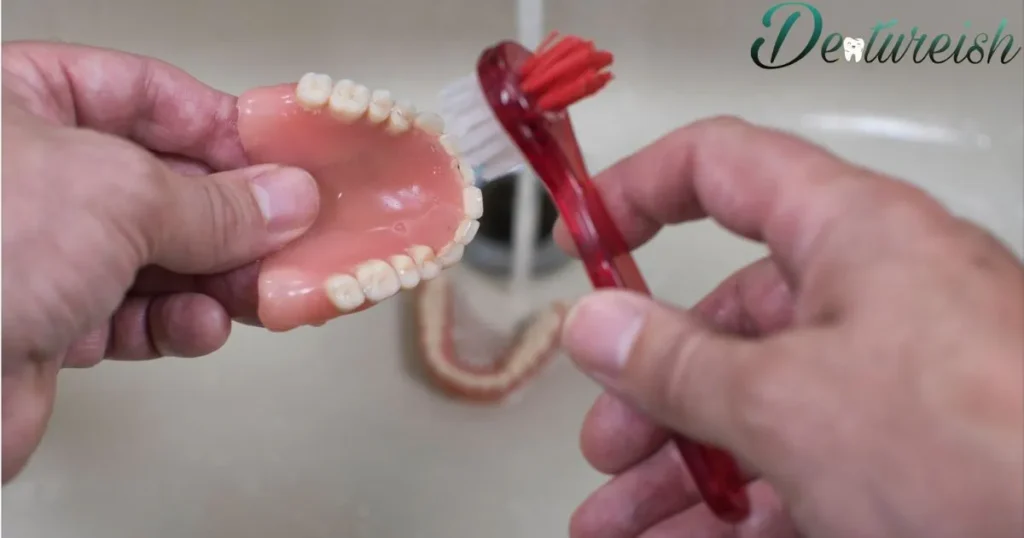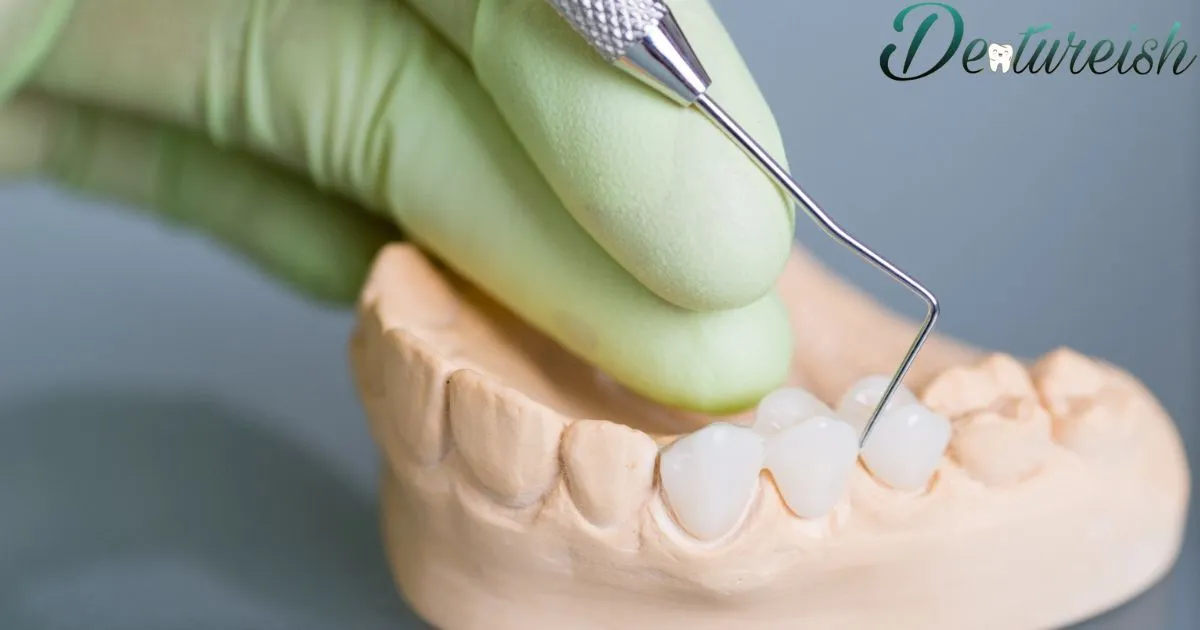Dentures are removable false teeth designed to replace missing teeth. Dentures can sometimes become stuck in the mouth due to suction created by the close fit of the dentures against the gums and roof of the mouth. Getting stuck dentures out can be uncomfortable and frustrating.
How To Get Dentures Out That Are Stuck? This is a common question for denture wearers who have experienced the annoyance of stuck false teeth. Having dentures stuck in place can cause pain, discomfort, and embarrassment. Learning techniques to remove stuck dentures can provide relief when encountering this nuisance.
There are several methods to try to get dentures unstuck. Using denture adhesive solvents can help break the seal and suction. Carefully working the dentures back and forth while applying outward pressure may loosen them. Using fingers or utensils to press along the denture borders can also help pop them out. Taking care not to damage the shape and fit of stuck dentures during removal is important. Patience and using proper technique will help get dentures unstuck.
How do you get stuck upper dentures out?
To remove stuck upper dentures, start by rinsing your mouth with warm water or a salt water solution to help loosen the adhesive’s grip. You can also try inserting your thumbs under the front of the dentures and gently prying upwards and outwards towards your nose. Going slowly and carefully is key – don’t yank or pull too hard.
If you still can’t get them out, try massaging your gums with a warm, wet washcloth or very soft toothbrush to further help dislodge the dentures. Getting stuck upper dentures out takes patience and care.
What causes upper dentures to get stuck?
- Poor fit: If your upper dentures are not properly fitted, they can get stuck due to a lack of air between the denture and the palate, which breaks the suction1.
- Changes in gum and bone structure: Over time, the gums and bone structure supporting the dentures can change, causing the dentures to lose their fit and potentially get stuck1.
- Food particles: Food getting stuck under the dentures can lead to them becoming lodged and difficult to remove, especially if not cleaned regularly2.
- Excessive use of adhesive: Using too much denture adhesive can cause the dentures to get firmly attached to the gums and palate, making them difficult to remove4.
- Long-term wear: Wearing dentures 24/7 can lead to gum sores, irritation, and potential infections, which can contribute to the dentures getting stuck12.
How can you loosen tightly fitting upper dentures?
If your upper dentures fit too snugly, making them hard to remove, try rinsing with warm salt water or a mouthwash to help gently loosen their seal and grip on your gums. You can also try massaging around the borders of the dentures with a warm, wet washcloth in a circular motion, which may ease some of the suction.
In some cases, you may need to visit your dentist to have the dentures adjusted for a looser, more comfortable fit. Trying to force out tight-fitting upper dentures can damage your gums and the dental appliances themselves.
What home remedies help remove stuck upper dentures?
Massaging around the dentures with a wet washcloth, using an oral syringe to direct a stream of warm water under the dentures, and applying a small amount of petroleum jelly to help lubricate the dentures away from the gums.
Always prioritize the health and comfort of your mouth when faced with the need to manage or resolve issues related to partial dentures, including the proper care when sleeping with partial dentures in your mouth.
When should you see a dentist for stuck upper dentures?
You should visit your dentist if you are unable to remove your upper dentures after trying various at-home loosening methods. Seek prompt dental attention if the stuck dentures are causing you severe discomfort, pain, or bleeding. Leaving dentures stuck in your mouth for too long can cause gum irritation, sores, and other oral health issues.
Your dentist has specialized tools and training to safely remove the dentures without damaging your gums or the dental appliances themselves. They can also examine why the dentures got so firmly stuck and make any necessary adjustments so it doesn’t happen again. Don’t try prying out extremely stuck dentures yourself.
How do you get stuck lower dentures out?
To remove stuck lower dentures, first rinse your mouth with warm water or a warm salt water solution to help loosen the adhesive seal. You can also try massaging your gums gently with a wet washcloth.
When ready to remove the dentures, place your thumbs on the sides of the dentures and gently rock them back and forth while pulling down and outwards. Go slowly and carefully, applying even pressure on both sides. Avoid yanking or pulling too hard on one side as this can damage the dentures or your gums.
Why do lower dentures get stuck sometimes?
Lower dentures can become stuck due to excessive use of denture adhesive which bonds them too tightly to the gums. They may also become stuck if left in the mouth too long without removal and cleaning.
As we age, our jawbone resorbs over time which can change the shape of gums, causing a tighter fit with lower dentures. Ill-fitting lower dentures that don’t have enough space along the gumline can be prone to getting stuck. Health conditions like dry mouth or infections can also contribute to lower dentures getting stuck on gums.
How to gently pry out stuck lower dentures?

If warm water and massage don’t loosen stuck lower dentures, you can try gently prying them out using clean hands, a spoon handle or a denture removal tool. Place the tool along the edge of the dentures, avoiding the front teeth.
Apply very gentle pressure working around the dentures, releasing a little bit at a time. Take care not to chip or crack the dentures. Go slowly and carefully. Stop if there is bleeding or increased pain.
What can you use to lubricate stuck lower dentures?
To help lubricate dentures stuck on gums, try using some KY jelly, olive oil, coconut oil or denture lubricating gel along the border of the dentures prior to removal. This helps reduce suction and friction, allowing the dentures to slide out more easily.
Just place a small dab of the lubricant onto a clean finger or cotton swab then run it along the edges of the dentures before trying to remove them.
When is professional help needed for stuck lower dentures?
Seek help from your dentist or denturist right away if you experience severe pain, bleeding, swelling or injury when trying to remove stuck lower dentures. Also contact your dental professional if warm water, massage and gentle prying at home do not get lower dentures unstuck after several attempts.
Leaving dentures stuck in place for too long can cause gum damage and oral infections. Getting professional assistance removes them properly and evaluates if adjustments, relining or replacements are needed for properly fitting lower dentures.
Why do partial dentures get stuck and not come out?
Partial dentures can get stuck due to an excessive buildup of plaque, tartar, or adhesive. As plaque and tartar accumulate around the clasps and connectors of the partial denture over time, they can create a tighter grip that makes the partial harder to remove.
Using too much denture adhesive can also lead to a suction effect that sticks the partial in place. In addition, changes to the shape of gums over time may alter how well the partial denture fits, contributing to it getting stuck.
What makes partial dentures get stuck?
There are a few key things that can cause a partial denture to become firmly lodged in place. An overgrowth of gum tissue around the abutment teeth can change the shape of gums so the partial no longer fits properly.
Accumulation of plaque, tartar, and food debris around the clasps and connectors creates a tighter grip. Excess saliva production while sleeping can also create suction that sticks the partial denture.
Using too much denture adhesive or incorrect application techniques are another culprit. Failing to properly clean the partial denture nightly allows plaque buildup over time.
Tips for removing stuck partial dentures yourself
If your partial denture is stuck, avoid yanking or pulling forcefully as this risks damage. First, thoroughly rinse the denture and mouth with warm water to help loosen debris. Try gently rocking or twisting the partial to break the seal. Use an over-the-counter denture adhesive solvent.
Massage areas where the partial is stuck to relieve suction. Be patient and try again later if unsuccessful at first. See an emergency dentist right away if oral pain, bleeding, swelling, or infection symptoms arise.
What solutions help release stuck partial dentures?
Using warm water is an effective at-home solution for loosening stuck partial dentures. Denture adhesive removal solutions containing chemicals like mineral oil can help dissolve denture paste.
Ultrasonic cleaners may help remove tartar or plaque buildup so the partial releases more readily. In some cases, a dentist may need to use special tools to manually detach a firmly stuck partial denture if at-home solutions fail. They can identify and resolve any underlying fit, gum overgrowth, or oral hygiene issues contributing to the problem.
Signs you need an emergency dentist for stuck partial dentures
See an emergency dentist right away if you experience bleeding, swelling, sores, or pain when trying to remove a stuck partial denture. These could indicate tissue irritation, infection or an ill-fitting partial injury.
Also seek immediate help if you are unable to remove the partial after multiple attempts using warm water or over-the-counter solvents. Leaving a stuck partial in place for too long raises infection risks and can cause further damage.
An emergency dentist can properly remove the partial, address any trauma, and make adjustments so it does not get stuck again.
What causes dentures to get so stuck they won’t come out?

Excessive use of dental adhesive is a common cause of dentures getting very firmly stuck in place and difficult to remove. As adhesive builds up over time in the crevices of the dentures, it can create a very strong bond that is hard to break.
Ill-fitting dentures that don’t properly fit the gums and palate can also lead to very firm sticking as the suction effect takes hold.
How do ill-fitting dentures get firmly stuck?
Ill-fitting dentures rely too much on suction to stay in place. As the denture presses tightly against the gums and palate, a vacuum seal is created that firmly locks the denture in position. This suction effect strengthens over time as the denture settles into position, making the denture extremely difficult to dislodge. Any small movements of the denture can also increase suction.
Methods to carefully loosen dentures stuck very tightly
Start by rinsing the mouth with warm water to help loosen the adhesive bond and weaken suction. Place fingers or thumbs on both sides of the denture and gently rock it back and forth, applying even pressure to slowly break the seal. Don’t pull too hard initially or the denture could damage soft tissues. Be patient and persistent, the denture will gradually loosen its grip.
What home products help loosen dentures stuck badly?
Denture adhesive remover wipes can penetrate adhesive and make dentures easier to remove. Denture cleanser solution also helps break down adhesive bonds. For ill-fitting dentures, try placing dentures in warm water for 5-10 minutes to reduce suction before removal. Don’t forcefully yank dentures as it risks damage.
How to prevent dentures from getting stuck again?
To prevent dentures from getting stuck again, it’s important to properly care for them by cleaning them daily and soaking them in denture cleaner overnight. Avoid using abrasive cleaners that can scratch the dentures.
It’s also critical to see your dentist regularly to get the dentures adjusted and realigned as needed when your mouth changes shape over time. Using denture adhesives sparingly can also help secure loose dentures.
Why do dentures keep getting stuck repeatedly?
Dentures may get repeatedly stuck if they don’t fit properly or have become misaligned over time as the mouth changes shape. Ill-fitting dentures can create pressure points and suction that lead to them getting stuck.
Lack of proper daily cleaning allowing plaque or food debris to build up under the dentures can also cause them to become stuck. Insufficient moisture under the dentures from reduced saliva can also create suction leading to stuck dentures.
Adjustments and denture adhesives to stop stuck dentures
Getting periodic denture adjustments from your dentist is key to ensuring a proper fit over time. As the gums and bone change shape, dentures need realignment and reshaping to avoid pressure points leading to stuck dentures.
Using small amounts of denture adhesive can also help fill gaps to prevent suction from building up under loose dentures. However, adjustments and adhesives shouldn’t be used to compensate for poorly-made dentures.
Proper denture cleaning prevents stuck dentures
Proper denture cleaning is essential to prevent dentures from getting stuck. Regular brushing with a soft-bristled denture brush and non-abrasive cleaning agent helps eliminate food debris and bacteria, reducing the risk of stuck dentures.
Rinsing the mouth and dentures after eating, using a denture cleaner, and soaking the dentures in a cleaning solution overnight can help maintain their cleanliness and prevent them from getting lodged. Here’s a table summarizing the key points from the search results:
| Proper Denture Cleaning Tips |
| 1. Brush dentures daily with a soft-bristled brush and non-abrasive cleaner14. |
| 2. Rinse mouth and dentures after eating to dislodge food particles2. |
| 3. Soak dentures in a cleaning solution overnight to prevent bacterial buildup4. |
| 4. Clean grooves that touch the gums and use a water flosser for hard-to-reach areas2. |
| 5. Ensure dentures fit properly to avoid discomfort and potential sticking5. |
Following these tips can help individuals maintain clean dentures and reduce the likelihood of them getting stuck.
Seeing a dentist ensures properly fitted dentures
Getting dentures professionally fitted and seeing a dentist for periodic realignment is crucial for proper fit and function over time. As the gums and bone change shape, even well-fitted dentures will need adjustment and reshaping to avoid pressure points that lead to stuck dentures.
Frequently Asked Question
How can I loosen stuck upper dentures?
Gently press your thumb between the denture and cheek, then down where it meets the gums to loosen upper dentures.
What helps remove stuck lower dentures?
Place your fingers on both sides of lower dentures and gently rock them side-to-side while pulling down to loosen stuck lower dentures.
Why won’t my dentures come out easily?
Ill-fitting, loose dentures with suction can get stuck – see your dentist for an adjustment.
Can denture adhesive make dentures get stuck?
Excess denture adhesive can make dentures harder to remove – use minimal amounts.
How do I remove dentures after years of wearing them?
Long-term denture wearers may need to retrain facial muscles and adjust techniques to easily remove dentures.
Conclusion
When partial dentures get stuck, it can be a frustrating and uncomfortable experience. However, there are several methods to help release them. Rinsing the mouth with warm water can help loosen the denture, and it’s important to avoid applying excessive pressure during the removal process to prevent damage.
Seeking the assistance of a dentist is recommended if the dentures cannot be removed easily at home. If you find your partial dentures stuck, there are some tips to aid in their removal.
Gently wiggling them back and forth, using denture adhesive remover or denture tablets, and maintaining good denture hygiene can all help release the dentures. Seeking the help of a dentist is crucial if you are unable to remove the dentures yourself, as they have the expertise and tools to safely resolve the issue.

